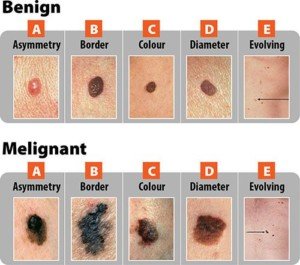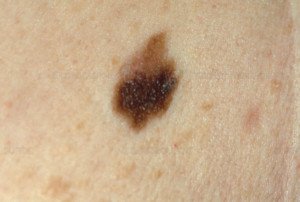
What if a melanoma doesn’t conform to the ABCDE guidelines?
Melanoma can pass as a normal mole simply because there’s always a beginning to this disease process.
In very early melanoma, the ABCDE guidelines don’t always apply.
“Melanoma can have many different looks — the lesions may be black, brown, bluish, red or even flesh color,” Gary Goldenberg, MD, of Goldenberg Dermatology, and assistant professor of dermatology and pathology at Mount Sinai School of Medicine.
A normal mole can be raised. Dr. Goldenberg says that melanoma “can be flat or stick out from the skin surface.
Early melanomas are usually flat, and patients are sometimes surprised that a flat lesion can be dangerous. Early melanomas often look benign (normal) to an untrained eye.”
However, a trained eye can miss a melanoma if the disease is early enough, especially if that trained eye does not know what the mole looked like a month or a few months prior.
The ABCDEs for Melanoma
A = asymmetry. The spot is not equal on either side of a dividing line. However, a normal mole can be asymmetrical, especially if it’s large.

An asymmetrical mole, though this is considered an atypical mole. Source: Biophoto Associates/Science Source
B = border. The border is jagged or erratic. Again, a normal mole can have this feature.
C = color. A normal mole can be any shade of brown, even black, and may even appear purple or blue due to minute vascularity underneath.

Blue mole. Dannii Brighton, CC
D = diameter. A normal mole can be larger than a pencil eraser, and a melanoma that arises in the absence of a pre-existing mole has to start out somewhere: a tiny pinpoint.
E = evolving. This is the key. Has that black mole always been black? Has that “funny” mole always been asymmetrical or had ragged edges? Has that spot on your back always been the diameter of a dime?
“As melanomas progress, they may become more of a bump – that’s called nodular growth phase,” says Dr. Goldenberg.
“These are the most dangerous lesions, since they grow into the skin and can spread to other organs.”
A melanoma is as deep as it is high.
If it’s 2 mm above the skin, it’s 2 mm beneath the skin.
“There is a misconception that a mole with hair growing through it is more likely to become melanoma; it’s simply not true.
“This is why I tell my patients to have their moles checked once per year and to see me if there is a new or changing lesion.”










































